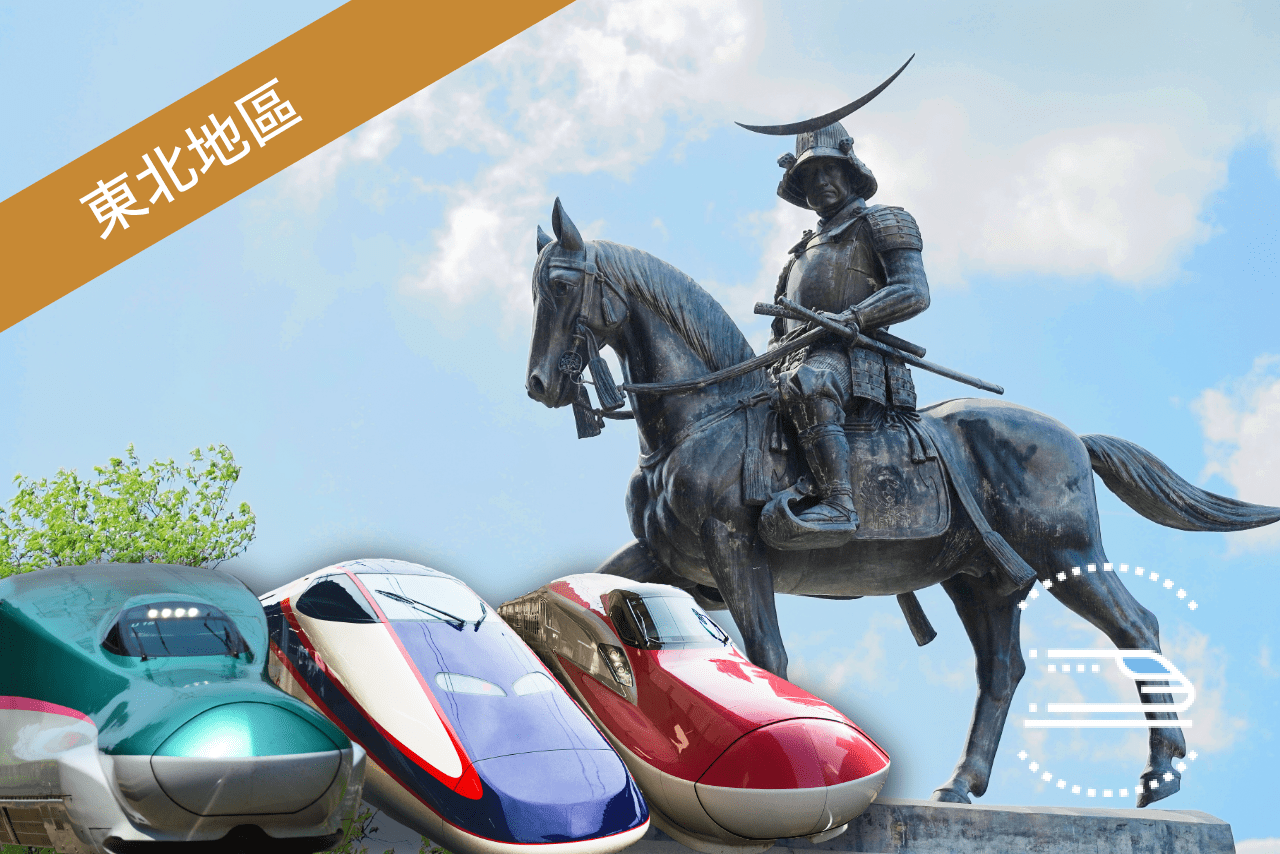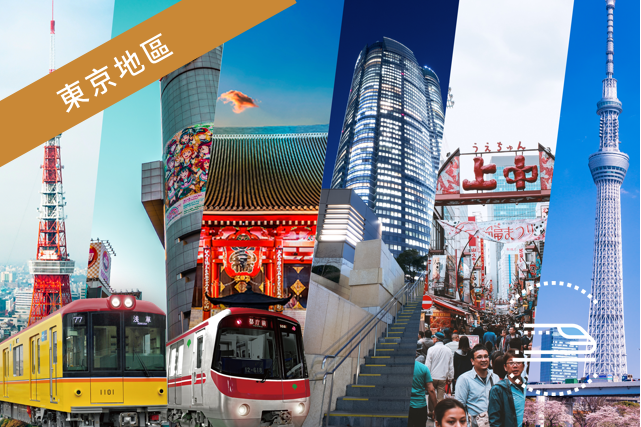
東京
可感受日本最新文化,刺激滿載的大都市
位於日本列島中心的東京,有高樓林立的都市,也有海拔2,000米的山脈和在太平洋上飄浮的伊豆群島,各種不同面貌的風景座落在這城市裡。例如集結最新時尚的澀谷、高貴奢華的銀座、次文化聖地秋葉原、傳統風情滿溢的淺草,還有可感受四季的日式庭園等,繁華市街與散發寧靜氛圍的空間相容並存。同時也集結了老字號的壽司店、各國料理,如樂園般的餐廳,眾多美食令人目不暇給。是一座滿足人們好奇心,魅力十足的大都市。
東京的熱門觀光地區

新宿
購物、美食與摩天大樓!應有盡有的繁華街道

秋葉原
霓虹燈眩目的電器街兼日本知名次文化聖地

池袋
以貓頭鷹為象徵!高樓林立、充滿豐富文化的繁華商圈

築地
大型魚市場新鮮直送!美味海鮮就在這裏

品川
現代建築與自然綠意共存的辦公大樓街道

羽田機場
洋溢傳統日式風情與流行次文化的日本最大機場

台場
能同時享受購物與夜景的東京灣休閒人工島

淺草
復古又嶄新!以雷門大燈籠為地標的東京下町

上野
可愛熊貓超人氣!藝術巡禮與購物一次滿足

吉祥寺
個性十足雜貨店、居酒屋、翠綠公園共存的街道

原宿・表參道
匯集日本流行文化與最新時尚潮流的購物街道

澀谷
以忠犬八公與巨大十字路口聞名的年輕人聚集地

下北澤
集結古着、音樂、劇場、藝術的次文化聖地

東京車站
具歷史性的建築!可盡享手信購物樂趣的東京交通轉運站

自由之丘
集合時尚咖啡店、甜品與日式精品的迷人街道
東京周邊知名景點
東京旅遊攻略
東京的推薦必訪景點
各季節旅遊重點
東京的Spring天 Mar. - May
東京市區的綠化規劃相當完善,特別在櫻花盛開的3月下旬至4月上旬時,總是吸引許多賞櫻遊客前往目黑川、上野恩賜公園、千鳥淵等賞櫻名勝。夜晚點上燈光的夜櫻也是不容錯過的美景。東京春天的溫差大,建議早晚穿上外套保暖,但同時雨量也偏少,可以說是相當適合旅行的季節。
氣溫
- 3月:5°C〜14°C,平均氣溫9°C
- 4月:9°C〜19°C,平均氣溫14°C
- 5月:14°C〜23°C,平均氣溫18°C
※氣溫參考:日本氣象廳過去的氣象統計資料

東京的Summer天 Jun. - Aug.
6月底至7月梅雨季結束後,東京隨即進入炎夏季節!晴天時可到台場的海水浴場,或是奧多摩山進行戶外活動;也可以前往較遠的伊豆群島或小笠原群島感受南國風情。7月至8月的煙花大會是夏天的重頭戲,發放多達2萬發煙花的隅田川煙花大會,除了岸邊之外,許多內行人也會乘搭屋形船欣賞煙火。黃昏天氣轉涼後,推薦到街上參加夏日祭典活動也是相當不錯的選擇。
氣溫
- 6月:18°C〜26°C,平均氣溫21°C
- 7月:22°C〜29°C,平均氣溫25°C
- 8月:23°C〜31°C,平均氣溫26°C
※氣溫參考:日本氣象廳過去的氣象統計資料

東京的Autumn天 Sept. - Nov.
9月中旬至下旬氣溫下降,此時的東京秋高氣爽,氣候舒適宜人。11月開始楓葉逐漸變色,可在日式庭園或公園內欣賞被染成紅色及黃色的楓葉美景,同時悠閒野餐。可到六義園一邊欣賞庭園之美、一邊品茶,或者前往高尾山或御岳山登山健行賞楓。東京的秋天,是個能享受散步樂趣、充份感受大自然美麗的季節。
氣溫
- 9月:20°C〜27°C,平均氣溫23°C
- 10月:14°C〜22°C,平均氣溫18°C
- 11月:8°C〜16°C,平均氣溫12°C
※氣溫參考:日本氣象廳過去的氣象統計資料

東京的Winter天 Dec. - Feb.
寒冷冬季依然不減東京魅力!點綴上聖誕燈飾的銀座、澀谷、六本木等時尚景點,可說是東京夜晚最繽紛奪目的季節。1月新年期間還有神社寺院的新年參拜,以及各大百貨新年初賣折扣等精彩豐富的活動。晴朗的冬日由於空氣特別清新,有較多機會能夠眺望遠方美景,推薦可從東京晴空塔或東京鐵塔等高處,遠眺富士山及東京灣,用不同角度欣賞東京周邊的絕美景色。
氣溫
- 12月:3°C〜12°C,平均氣溫7°C
- 1月:1°C〜9°C,平均氣溫5°C
- 2月:2°C〜10°C,平均氣溫6°C
※氣溫參考:日本氣象廳過去的氣象統計資料

關於東京旅遊的常見問題
去東京旅行時,使用哪一種交通票券或周遊券較實惠呢?
若在24小時內會乘搭地下鐵超過5次,推薦使用「Tokyo Subway Ticket」,即可自由乘搭東京Metro地下鐵全線及都營地下鐵全線,票券共有24/48/72小時3種類型。前往東京近郊則推薦「JR TOKYO Wide Pass」。票券適用範圍不僅限於東京都內,還包括東京近郊JR全線與當地鐵路,因此可考慮前往成田機場、日光、富士山、輕井澤等近郊的人氣景點。
【詳細資訊】
・7張東京觀光必備的超值一日券東京都內有什麼推薦的1日觀光行程嗎?
想在1天內玩盡東京主要景點並不容易,為大家推薦可以一次感受東京各種不同面貌的經典景點行程。
行程路線:淺草寺→東京晴空塔→銀座→澀谷・原宿→新宿
從東京觀光首選的老街「淺草」出發,登上「東京晴空塔」遠眺東京市街,再前往世界名牌店林立的「銀座」,以及帶領流行潮流的「澀谷・原宿」,雖說銀座與澀谷皆是時尚的代表區,但店舖及氛圍截然不同;最後再前往高樓林立的繁華街道「新宿」欣賞東京夜景,為一日東京觀光行程畫上完美的句點。
前往東京旅遊時,應該飛往成田機場還是羽田機場呢?
成田機場位於千葉縣,羽田機場則在東京都。由成田機場前往東京車站,最快的電車約需1小時,從羽田機場只需約30分鐘即可到達。
從香港出發的話,有很多飛往成田或羽田的航班,但依照航空公司的不同,飛機班次與時間也有所不同。建議可以整體評估機票、航班時間、目的地等後,再選擇機場。
從成田機場及羽田機場前往東京都內時,搭什麼車最快速又實惠呢?
從各個機場前往東京市區可選擇乘搭電車、單軌電車或巴士。乘搭電車會比較容易掌握時間也比較便宜,在成田機場可乘搭電車JR線或京成線,最快抵達上野站的是「京成SKY LINER」,只需約40分鐘。若是前往東京站則可乘搭所需時間約1小時的高速巴士,經濟實惠。
從羽田機場乘搭東京單軌電車到濱松町站、或乘搭京急線到品川站,皆需約13分鐘左右。
【詳細資訊】
・成田機場來往東京市區交通攻略總整理
・羽田機場來往東京市區交通路線解說東京有哪些必去的最新觀光景點?
近年來東京有許多明顯的變化,像是澀谷站前重新開發工程,從全新開幕的「澀谷SCRAMBLE SQUARE」可用不同角度俯瞰東京街景,車站附近被重新打造的「宮下公園」與集結許多店鋪及餐廳的複合設施「RAYARD MIYASHITA PARK」連在一起。
此外,JR山手線上更增設了新車站「高輪Gateway站」,車站附近也有規劃預計今後開幕的購物中心等。接下來東京也會陸續增加許多新景點,相當值得期待!
東京之旅除了購物之外,有沒有能夠享受大自然或藝術文化的地方呢?
來到東京旅行,若想親近大自然,推薦到西邊的高尾山或御岳山,享受行山健行樂趣。
要欣賞陶藝或浮世繪等日本傳統文化,則可到「三得利美術館」、「根津美術館」、「墨田北齋美術館」,以及擁有日本最大規模展示空間的「國立新美術館」。
在聚集多間美術館的上野恩賜公園附近,也有「國立西洋美術館」、「東京都美術館」、「上野之森美術館」等,經常舉辦許多企劃展覽活動,非常值得一訪。
【詳細資訊】
・9間東京推薦的美術館及博物館東京旅遊時住在哪裡最方便?
決定住宿地點時,建議可以根據喜愛的區域及旅遊目的來做選擇。
若以購物為目的時,可選擇購物地點眾多的澀谷或新宿、銀座等。位於購物中心集中地的池袋也有不少價格實惠的住宿設施。若是考慮到往來機場的便利性,則推薦上野或淺草、品川等地。
想好好暢玩到夜晚的旅客,建議可選擇距離夜間景點較近、或是交通方便的地點。
東京都內哪裡可以浸溫泉?
若想體驗正宗溫泉,推薦到東京巨蛋城的「Spa LaQua」,露天浴池、碳酸溫泉、以及低溫桑拿等一應俱全。
另外,鄰近舊市街巢鴨站的「染井溫泉SAKURA」內設有檜木大浴場及露天浴池等,可感受寧靜寫意的時光,令人幾乎忘記自己置身於東京。在新宿則有24小時營業的「Thermae湯」,可依照需求喜好以及既定行程自由選擇。
【詳細資訊】
・東京與近郊熱門溫泉設施在東京觀光有需要租車嗎?
東京都內的電車、巴士等公共交通網絡四通八達,只在市區內的景點觀光移動的話,不太需要租車。但若是到距離電車車站較遠的郊外,或是有小孩、長者同行時,租車或許會比較方便。在各大車站附近皆有租車公司,建議出發前先查好想前往地區的租車服務地點。
想從東京出發去滑雪的話,有推薦的地點嗎?
從東京乘搭新幹線或巴士,就能輕鬆去即日來回的滑雪之旅。由東京出發約75分鐘可抵達的地點包括新潟縣的「GALA湯澤滑雪度假村」、長野縣的「輕井澤王子大飯店滑雪場」。
乘搭新幹線約2小時則可抵達新潟縣的「舞子滑雪度假村」、以及群馬縣的「NORN水上滑雪場」。這些滑雪場皆設有各式難易程度的滑雪道,其中也有附設天然溫泉的滑雪場,無論是當日來回或住宿當地,都能盡情享受滑雪之樂。
【詳細資訊】
東京近郊4大推薦人氣滑雪場













































